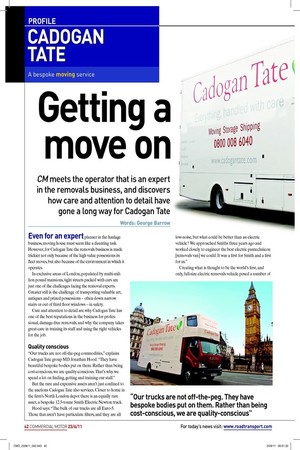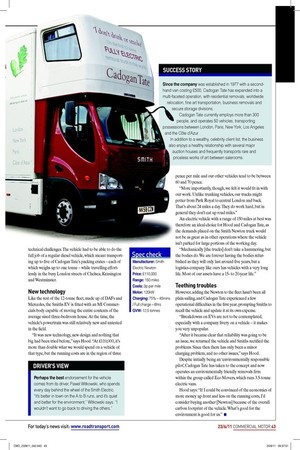Getting a move on
Page 36

Page 37

If you've noticed an error in this article please click here to report it so we can fix it.
CM meets the operator that is an expert in the removals business, and discovers how care and attention to detail have gone a long way for Cadogan Tate Words: George Barrow Even for an expert planner in the haulage business, moving house must seem like a daunting task. However, for Cadogan Tate the removals business is made trickier not only because of the high value possessions its leet moves, but also because of the environment in which it operates.
In exclusive areas of London, populated by multi-million pound mansions, tight streets packed with cars are just one of the challenges facing the removal experts. Greater still is the challenge of transporting valuable art, antiques and prized possessions – often down narrow stairs or out of third loor windows – in safety.
Care and attention to detail are why Cadogan Tate has one of the best reputations in the business for professional, damage-free removals, and why the company takes great care in training its staff and using the right vehicles for the job.
Quality conscious
“Our trucks are not off-the-peg commodities,” explains Cadogan Tate group VID Jonathan Hood. “They have beautiful bespoke bodies put on them. Rather than being cost-conscious, we are quality-conscious. That’s why we spend a lot on inding, getting and training our staff.” But the rare and expensive assets aren’t just conined to the auctions Cadogan Tate also services. Closer to home in the irm’s North London depot there is an equally rare asset, a bespoke 12.5-tonne Smith Electric Newton truck.
Hood says: “The bulk of our trucks are all Euro-5. Those that aren’t have particulate ilters, and they are all low-noise, but what could be better than an electric vehicle? We approached Smiths three years ago and worked closely to engineer the best electric pantechnicon [removals van] we could. It was a irst for Smith and a irst for us.” Creating what is thought to be the world’s irst, and only, full-size electric removals vehicle posed a number of technical challenges. The vehicle had to be able to do the full job of a regular diesel vehicle, which meant transporting up to ive of Cadogan Tate’s packing crates – each of which weighs up to one tonne – while travelling effortlessly in the busy London streets of Chelsea, Kensington and Westminster.
New technology
Like the rest of the 12-tonne leet, made up of DAFs and Mercedes, the Smiths EV is itted with an MI Commercials body capable of moving the entire contents of the average sized three-bedroom house. At the time, the vehicle’s powertrain was still relatively new and untested in the ield.
“It was new technology, new design and nothing that big had been tried before,” says Hood. “At £110,000, it’s more than double what we would spend on a vehicle of that type, but the running costs are in the region of three pence per mile and our other vehicles tend to be between 60 and 70 pence.
“More importantly, though, we felt it would it in with our work. Unlike trunking vehicles, our trucks might potter from Park Royal to central London and back. That’s about 24 miles a day. They do work hard, but in general they don’t eat up road miles.” An electric vehicle with a range of 150 miles at best was therefore an ideal choice for Hood and Cadogan Tate, as the demands placed on the Smith Newton truck would not be as great as in other operations where the vehicle isn’t parked for large portions of the working day.
“Mechanically [the trucks] don’t take a hammering, but the bodies do. We are forever having the bodies refurbished as they will only last around ive years, but a logistics company like ours has vehicles with a very long life. Most of our assets have a 15to 20-year life.”
Teething troubles
However, adding the Newton to the leet hasn’t been all plain sailing, and Cadogan Tate experienced a few operational dificulties in the irst year, prompting Smiths to recall the vehicle and update it at its own expense.
“Breakdowns on EVs are not to be contemplated, especially with a company livery on a vehicle – it makes you very unpopular.
“After it became clear that reliability was going to be an issue, we returned the vehicle and Smiths rectiied the problems. Since then there has only been a minor charging problem, and no other issues,” says Hood.
Despite initially being an ‘environmentally responsible pilot’, Cadogan Tate has taken to the concept and now operates an environmentally friendly removals irm within the group called Eco Movers, which runs 3.5-tonne electric vans.
Hood says: “If I could be convinced of the economics of more money up front and less on the running costs, I’d consider buying another [Newton] because of the overall carbon footprint of the vehicle. What’s good for the environment is good for us.” ■













































